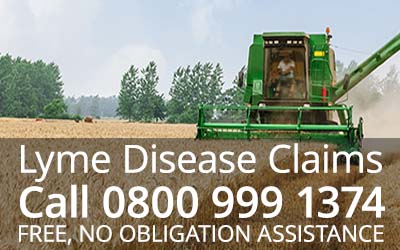
The Stages of Lyme Disease
Most tick bites do not transmit Lyme disease, as the majority of ticks do not carry the bacteria, but if you are bitten by one that has previously bitten an infected animal, then the bacteria will begin to spread through the body in three clear stages:
Stage 1 – Early localised disease
The symptoms of Lyme disease usually start within a week or two of being bitten, but in some cases the symptoms are not noticed for weeks, months or even years after the actual bite. The most common and well-known symptom in the early stage of the disease is the bullseye rash which is a clear sign that the bacteria are multiplying within the bloodstream around the bite wound. This rash does not hurt and rarely itches, but can be clearly visible, depending upon the location of the bite on the body – in many cases ticks will climb into a warm, damp area such as the groin or armpit where the rash can be more difficult to see. If treated appropriately at stage 1, the disease is unlikely to cause any further issues.
Stage 2 – Early disseminated Lyme disease
Once the bacteria begins to spread throughout the body a range of ‘flu-like symptoms may develop including fever, chills and muscle ache, alongside a general feeling of illness. While the bullseye rash of stage 1 usually disappears after around four weeks, other rashes might appear on different parts of the body, and neurological issues such as tingling or numbness in certain areas may develop. If the disease is caught and treated properly at stage 2 a full recovery can be made with little chance of further complications.
Stage 3 – Late disseminated Lyme disease
This stage only occurs if the disease has not been appropriately diagnosed and treated during stages 1 and 2, and can occur weeks, months or even years after the tick bite itself. Characteristics of stage 3 include severe headaches, arthritis, brain disorders and even heart problems. While death is rarely attributed to Lyme disease on its own, it can be a contributory factor due to the way that it weakens the body and causes issues with mental function, fatigue and heart issues.
The NHS and most major medical groups suggest that the majority of cases of Lyme disease can be cured within around four weeks when treated with antibiotics, the main problem with this particular disease is the nature of the symptoms being easily mistaken for other conditions or illnesses, and hence appropriate treatment is not always given in time. That’s where Universa Law can help – contact one of our friendly solicitors today, free of charge and with no obligation to continue with a case if you should choose not to.
Call us now on 0800 999 1374 or click here to start your claim.

Claiming For Lyme Disease
Free Legal Advice
If you are unsure whether you can claim compensation for Lyme Disease, then call our personal injury claims team for free, no obligation advice on making a claim. They will ask you some simple questions about your condition, talk to you about what’s happened and can tell you if you have a viable claim for compensation or not. Call us free on 0800 999 1374.
Latest Lyme Disease News
Forestry Worker Claims £80,000 for Lyme Disease
A Scottish man who developed Lyme disease and became seriously ill has launched a legal claim for £80,000 against his employers for failing to do enough to protect workers from the potentially life-threatening disease.Iain MacEchern had worked for the Forestry...




